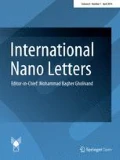Abstract
An ecofriendly and efficient procedure for the synthesis of silver nanoparticles (AgNPs) was performed using aqueous extract of Enteromorpha intestinalis as reducing, capping, and stabilizing agents. AgNPs were characterized by UV spectroscopy, Fourier transform infrared (FTIR), high-resolution transmission electron microscope (HRTEM), and EDX. Moreover, the optimum conditions for the green synthesis were studied and the antimicrobial activity were estimated by agar well diffusion and broth dilution methods. UV vis spectroscopy confirmed the formation of AgNPs due to their surface plasmon resonance. The optimum conditions for the biosynthesis of AgNPs were using 2.5 g or 5 g/100 ml (w/v) of algal biomasses for extraction, and 1 mM of silver ions within 72 h. Transmission electron micrographs showed that AgNPs were spherical in shape and with a mean average size of 9.17 ± 3.2 nm. FTIR revealed the that protein and polysaccharides are responsible for AgNPs synthesis. Additionally, AgNPs exhibited antimicrobial activity against all tested microorganisms. The minimum Inhibitory concentration for all bacteria and Candida albicans ATCC26555 was 6.25 µg/ml except Klebsiella Pneumoniae ATCC70603 and Staphylococcus aureus ATCC4330 was 12.5 µg/ml. Further studies will be recommended to estimate the cytotoxicity of these AgNPs on the human cell line. The future use of algae as green nanofactory will be important in medical applications.
Graphic abstract









Similar content being viewed by others
References
Abou El-Nour, K.M.M., Eftaiha, A., Al-Warthan, A., Ammar, R.A.A.: Synthesis and applications of silver nanoparticles. Arab. J. Chem. 3, 135–140 (2010). https://doi.org/10.1016/j.arabjc.2010.04.008
Burdusel, A.C., Gherasim, O., Grumezescu, A.M., Mogoanta, L., Ficai, A., Andronescu, E.: Biomedical applications of silver nanoparticles: an up-to-date overview (2018). Nanomaterials 8, 681 (2018). https://doi.org/10.3390/nano8090681
Rai, G.: Heavy metal tolerance in algae. In: Rai, L.C., et al. (eds.) Algal Adaptation to Environmental Stresses, Chap. 12. Springer-Verlag, Berlin (2001)
De Silva, M.W.R.N., Burrows, E.M.: An experimental assessment of the status of the species Enteromorpha intestinalis (L.) Link Enteromorpha Compressa (L.) Grev. (2009)
Messyasz, B., Rybak, A.: The distribution of green algae species from the Ulva genera (syn. Enteromorpha; Chlorophyta) in Polish inland waters (2009)
Horincar, V.-B., Parfene, G., Bahrim, G.: Evaluation of bioactive compounds in extracts obtained from three romanian marine algae species. Rom. Biotech. Lett. 16, 71–78 (2011)
Baskar, B.B.: Biosynthesis of silver nanoparticles using Kappa phycus species. IJRPS 3(3), 55–56 (2013)
Elumalai, D., Kaleena, P.K., Ashok, K., et al.: Green synthesis of silver nanoparticle using Achyranthes aspera and its larvicidal activity against three major mosquito vectors. Eng. Agric. Environ. Food 9, 1–8 (2016). https://doi.org/10.1016/j.eaef.2015.08.002
Thomas, R., Viswan, A., Mathew, J., Radhakrishnan, E.K.: Evaluation of antibacterial activity of silver nanoparticles synthesized by a novel strain of marine Pseudomonas sp. Nano. Biomed. Eng. 4, 139–143 (2012)
Krishnan, R., Arumugam, V., Vasaviah, S.K.: The MIC and MBC of silver nanoparticles against Enterococcus faecalis—a facultative anaerobe. J. Nanomed. Nanotechnol. 6, 285 (2015). https://doi.org/10.4172/2157-7439.1000285
Heath, J.R.: Size-dependent surface-plasmon resonances of bare silver particles. Phys. Rev. B: Condens. Matter 40, 9982–9985 (1989)
Hammud, H.H., El-Shaar, A., Khamis, E., Mansour, E.: Adsorption studies of lead by enteromorpha algae and its silicates bonded material. J.A.C. (2014). https://doi.org/10.1155/2014/205459
Akköz, C., Arslan, D., Ünver, A., Özcan, M.M., Yilmaz, B.: Chemical composition, total phenolic and mineral contents of Enteromorpha Intestinalis (L.) Kütz. and Cladophora Glomerata (L.) Kütz. seaweeds. J. Food Biochem. 35(2), 513–523 (2011). https://doi.org/10.1111/j.1745-4514.2010.00399.x
De Reviers, B., Leproux, A.: Characterization of polysaccharides from Enteromorpha intestinalis (L.) link, chlorophyta. Carbohydr. Polym. 22(4), 253–259 (1993). https://doi.org/10.1016/0144-8617(93)90128-q
Mubarak, A.D., Sasikala, M., Gunasekaran, M., Thajuddin, N.: Biosynthesis and characterization of silver nanoparticles using marine cyanobacterium, Oscillatoria willei NTDMO1. Dig. J. Nanomater. Bios. 6, 385–390 (2011)
Ahmed, E.A., Abdel Hafez, E.H., Ismail, A.F.M., El sonbaty, S.M., Abbas, H.S., Salah El Din, R.A.: Biosynthesis of silver nanoparticles by Spirulina platensis & Nostoc sp. GARJM IV(4), 36–49 (2015)
Masarudin, M.J., Cutts, S.M., Evison, B.J., Phillips, D.R., Pigram, B.J.: Factors determining the stability, size distribution, and cellular accumulation of small, monodisperse chitosan nanoparticles as candidate vectors for anticancer drug delivery: application to the passive encapsulation of [14C]-doxorubicin. Nanotechnol. Sci. Appl 8, 67–80 (2015)
Rejeeth, C., Nataraj, B., Vivek, R., Sakthivel, M.: Biosynthesis of silver nanoscale particles using Spirulina platensis induce growth-inhibitory effect on human breast cancer cell line MCF-7. J. Med. Aromat. Plants 3, 163 (2014). https://doi.org/10.4172/2167-0412.1000163
Gomaa, E.Z.: Antimicrobial, antioxidant and antitumor activities of silver nanoparticles synthesized by Allium cepa extract: a green approach. J. Genet. Eng. Biotechnol. 15, 49–57 (2017). https://doi.org/10.1016/j.jgeb.2016.12.002
Guzmán, M.G., Dille, J., Godet, S.: Synthesis of silver nanoparticles by chemical reduction method and their antibacterial activity. Int. J. Chem. Biol. Eng. 2, 04–111 (2009)
Author information
Authors and Affiliations
Corresponding author
Additional information
Publisher's Note
Springer Nature remains neutral with regard to jurisdictional claims in published maps and institutional affiliations.
Rights and permissions
About this article
Cite this article
Haglan, A.M., Abbas, H.S., Akköz, C. et al. Characterization and antibacterial efficiency of silver nanoparticles biosynthesized by using green algae Enteromorpha intestinalis. Int Nano Lett 10, 197–205 (2020). https://doi.org/10.1007/s40089-020-00305-x
Received:
Accepted:
Published:
Issue Date:
DOI: https://doi.org/10.1007/s40089-020-00305-x




